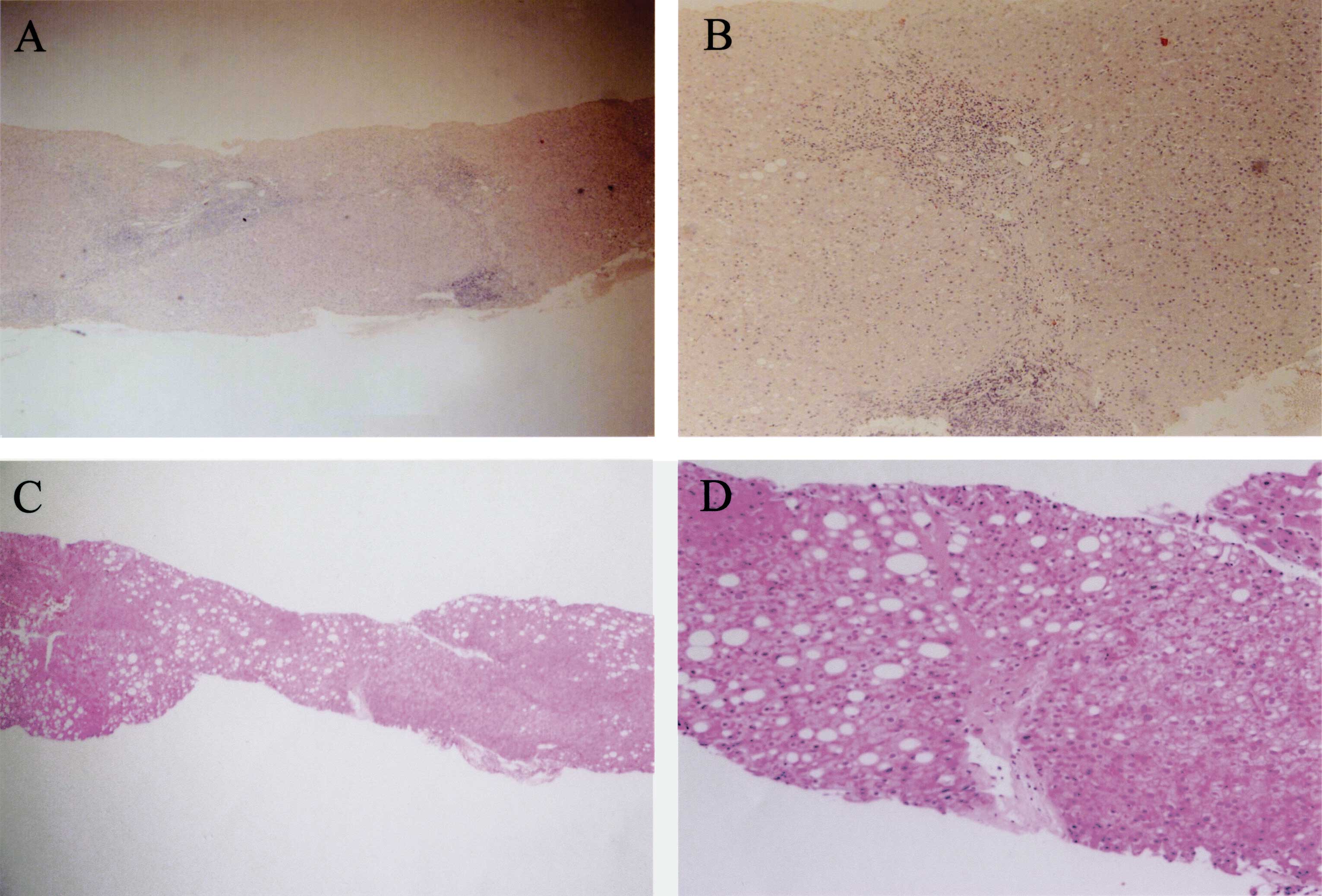|
1
|
Kiyosawa K, Tanaka E and Sodeyama T:
Hepatitis C virus and hepatocellular carcinoma. Curr Stud Hematol
Blood Transfus. 62:161–180. 1998. View Article : Google Scholar : PubMed/NCBI
|
|
2
|
Marcellin P, Boyer N, Gervais A, Martinot
M, Pouteau M, Castelnau C, Kilani A, Areias J, Auperin A, Benhamou
JP, Degott C and Erlinger S: Long-term histologic improvement and
loss of detectable intrahepatic HCV RNA in patients with chronic
hepatitis C and sustained response to interferon-alpha therapy. Ann
Intern Med. 127:875–881. 1997. View Article : Google Scholar : PubMed/NCBI
|
|
3
|
Reichard O, Glaumann H, Frydén A, Norkrans
G, Wejstål R and Weiland O: Long-term follow-up of chronic
hepatitis C patients with sustained virological response to
alpha-interferon. J Hepatol. 30:783–787. 1999. View Article : Google Scholar : PubMed/NCBI
|
|
4
|
Poynard T, Moussalli J, Ratziu V,
Regimbeau C and Opolon P: Effect of interferon therapy on the
natural history of hepatitis C virus-related cirrhosis and
hepatocellular carcinoma. Clin Liver Dis. 3:869–881. 1999.
View Article : Google Scholar : PubMed/NCBI
|
|
5
|
Yoshida H, Shiratori Y, Moriyama M, et al:
Interferon therapy reduces the risk for hepatocellular carcinoma:
national surveillance program of cirrhotic and noncirrhotic
patients with chronic hepatitis C in Japan. IHIT Study Group.
Inhibition of Hepatocarcinogenesis by Interferon Therapy. Ann
Intern Med. 131:174–181. 1999. View Article : Google Scholar
|
|
6
|
Ikeda K, Saitoh S, Arase Y, Chayama K,
Suzuki Y, Kobayashi M, Tsubota A, Nakamura I, Murashima N, Kumada H
and Kawanishi M: Effect of interferon therapy on hepatocellular
carcinogenesis in patients with chronic hepatitis type C: a
long-term observation study of 1,643 patients using statistical
bias correction with proportional hazard analysis. Hepatology.
29:1124–1130. 1999. View Article : Google Scholar
|
|
7
|
Fried MW and Hoofnagle JH: Therapy of
hepatitis C. Semin Liver Dis. 15:82–91. 1995. View Article : Google Scholar
|
|
8
|
Kasahara A, Hayashi N, Mochizuki K,
Takayanagi M, Yoshioka K, Kakumu S, Iijima A, Urushihara A,
Kiyosawa K, Okuda M, Hino K and Okita K: Risk factors for
hepatocellular carcinoma and its incidence after interferon
treatment in patients with chronic hepatitis C. Osaka Liver Disease
Study Group. Hepatology. 27:1394–1402. 1998. View Article : Google Scholar
|
|
9
|
Kurokawa M, Hiramatsu N, Oze T, et al:
Effect of interferon alpha-2b plus ribavirin therapy on incidence
of hepatocellular carcinoma in patients with chronic hepatitis.
Hepatol Res. 39:432–438. 2009. View Article : Google Scholar : PubMed/NCBI
|
|
10
|
Tamori A, Kuroki T, Nishiguchi S, Morimoto
H, Morimoto M, Hirohashi K, Kinoshita AH and Kobayashi K: Case of
small hepatocellular carcinoma in the caudate lobe detected after
interferon caused disappearance of hepatitis C virus.
Hepatogastroenterology. 43:1079–1083. 1996.PubMed/NCBI
|
|
11
|
Hirashima N, Mizokami M, Orito E, Koide T,
Itazu I, Kumada K, Sakakibara K, Kano H and Lau JY: Case report:
development of hepatocellular carcinoma in a patient with chronic
hepatitis C infection after a complete and sustained response to
interferon-alpha. J Gastroenterol Hepatol. 11:955–958.
1996.PubMed/NCBI
|
|
12
|
Tong MJ, Lai LP and Murakami-Mori K:
Development of hepatocellular carcinoma after clearance of
hepatitis C virus with interferon therapy. West J Med. 167:103–105.
1997.PubMed/NCBI
|
|
13
|
Yamaguchi K, Omagari K, Kinoshita H,
Yoshioka S, Furusu H, Takeshima F, Nanashima A, Yamaguchi H and
Kohno S: Development of hepatocellular carcinoma in a patient with
chronic hepatitis C after 6 years of a sustained and complete
response to IFN-alpha. J Clin Gastroenterol. 29:207–209.
1999.PubMed/NCBI
|
|
14
|
Miyano S, Togashi H, Shinzawa H, Sugahara
K, Matsuo T, Takeda Y, Saito K, Saito T, Ishiyama S, Kaneko M and
Takahashi T: Case report: occurrence of hepatocellular carcinoma
4.5 years after successful treatment with virus clearance for
chronic hepatitis C. J Gastroenterol Hepatol. 14:928–930.
1999.PubMed/NCBI
|
|
15
|
Yamada M, Ichikawa M, Matsubara A,
Ishiguro Y, Yamada M and Yokoi S: Development of small
hepatocellular carcinoma 80 months after clearance of hepatitis C
virus with interferon therapy. Eur J Gastroenterol Hepatol.
12:1029–1032. 2000. View Article : Google Scholar : PubMed/NCBI
|
|
16
|
Enokimura N, Shiraki K, Kawakita T, Saitou
Y, Inoue H, Okano H, Yamamoto N, Deguchi M, Sakai T, Ohmori S,
Fujikawa K, Murata K, Niki Y and Nakano T: Hepatocellular carcinoma
development in sustained viral responders to interferon therapy in
patients with chronic hepatitis C. Anticancer Res. 23:593–596.
2003.PubMed/NCBI
|
|
17
|
Kobayashi S, Takeda T, Enomoto M, Tamori
A, Kawada N, Habu D, Sakaguchi H, Kuroda T, Kioka K, Kim SR, Kanno
T, Ueda T, Hirano M, Fujimoto S, Jomura H, Nishiguchi S and Seki S:
Development of hepatocellular carcinoma in patients with chronic
hepatitis C who had a sustained virological response to interferon
therapy: a multicenter, retrospective cohort study of 1124
patients. Liver Int. 27:186–191. 2007. View Article : Google Scholar
|
|
18
|
Maylin S, Martinot-Peignoux M, Moucari R,
et al: Eradication of hepatitis C virus in patients successfully
treated for chronic hepatitis C. Gastroenterology. 135:821–829.
2008. View Article : Google Scholar : PubMed/NCBI
|
|
19
|
Tamori A, Nishiguchi S, Shiomi S, Hayashi
T, Kobayashi S, Habu D, Takeda T, Seki S, Hirohashi K, Tanaka H and
Kubo S: Hepatitis B virus DNA integration in hepatocellular
carcinoma after interferon-induced disappearance of hepatitis C
virus. Am J Gastroenterol. 100:1748–1753. 2005. View Article : Google Scholar : PubMed/NCBI
|















